Call for Undergraduates in Biology or Engineering Fields:
Are you a neuroscience nerd? Do you want to learn how the brains of animals like squids or dragonflies work? Is your background in Electrical, Mechanical or Computer Engineering? Want to develop your own innovative experiments and publish your results? Learn to communicate those stunning results with the public? Maybe even all of the above? Then you’re in luck!
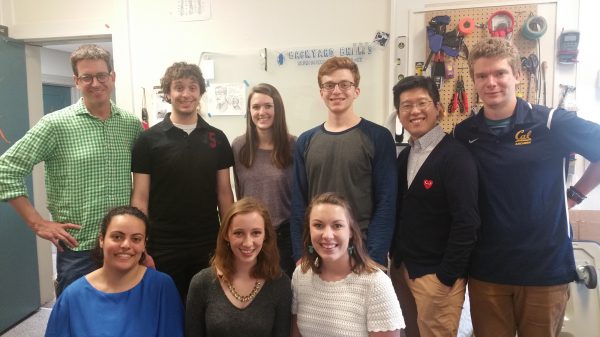
2017 Fellows from left to right: Top: Greg Gage (Not a fellow), Zach, Jaimie, Spencer, Nathan, Ilya. Bottom: Joud, Christy, Haley.
The Backyard Brains Summer Research Fellowship is an intensive 10 week program for undergraduates to participate in hands-on neuroscience research and experiment design with award winning neuroscientists. This is the 5th year of running our prestigious (and paid) summer program and this year it will run from May 21, 2018 to Aug 3, 2018 in Downtown Ann Arbor, MI. All applications must be received by noon eastern time (12:00 PM, EST) on March 22, 2018 to be eligible. We will be notifying applicants of their status by March 29, 2018.
Apply to the Summer Fellowship Today!

This is our 5th iteration of the program, and it just gets better every year. Like a fine wine! Our summer fellowship program is run much like a graduate school laboratory. All participants will be working on their own independent research projects for the whole summer. We will have daily journal clubs to go over key papers and expand knowledge in the area, and each participant will be trained how to develop their own experiments and to build their own devices to perform those experiments. You, future BYB scientist, will be collecting data, analyzing it, and presenting your results.
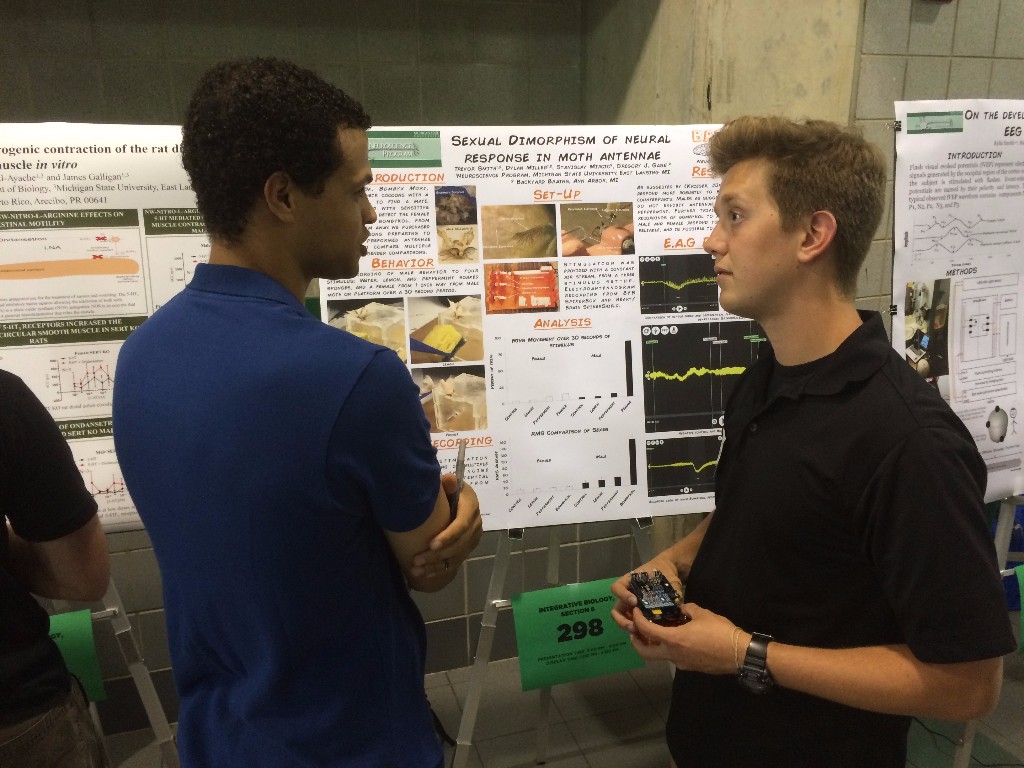
The end result of your summer fellowship will be a publishable experiment and video for our website, as well as a poster to be delivered at Undergraduate Research Poster Session of the Society for Neuroscience. In 2017, all of our participants presented their research at a Undergraduate Research conference and some were selected to be posters at the Society for Neuroscience Conference. We also brought home the hardware to show for the hard work: all of our research fellows will be featured in a new TED show called “DIY Neuroscience,” which will begin airing on March 14. We will work with each student to prepare a 10 minute TED-style talk for a public event in Ann Arbor, with the possibility of presenting at our annual TEDx event. We have also worked with students to continue refining their experiment writeups into manuscripts in order to publish first-authored papers in peer-reviewed journals.
Apply to the Summer Fellowship Today!
Media Coverage of Past Intern Projects
As interns, you can receive media coverage by the popular press. See below for previous examples:
Two Interns Win Hackaday’s Citizen Scientist Challenge
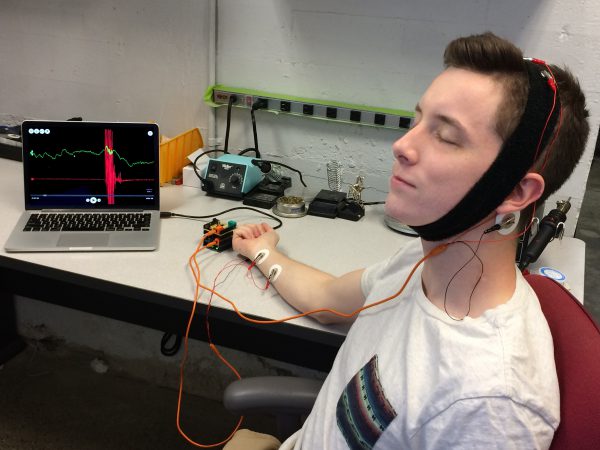
Arduino, EEG and Free Will by Patrick Glover
“If the brain had already been preparing to perform the action for nearly half a second before the individual consciously “decides” to perform the action, did the individual actually… decide?” Read the full article here.

Neuroscience of Grasshopper Jumps by Dieu My Nyugen
“Why are they hard to catch? Because they can quickly jump away when a person or another insect or object approaches it. How are they able to quickly hop away to escape a potential predator or avoid collision with an object? To address this specific question, I will look into the movement detector neurons in the grasshopper’s brain—the organ that fascinates me.” Read the full article here.
Optogenetics Featured In Hackaday
“Cort Thompson is working with fruit flies genetically modified so a neuron will activate when they’re exposed to a specific pulse of light. It’s called optogenetics, and [Cort] has a few of these guys who have an ‘I’m tasting something sweet’ neuron activated when exposed to a pulse of red light.” Read the full article here
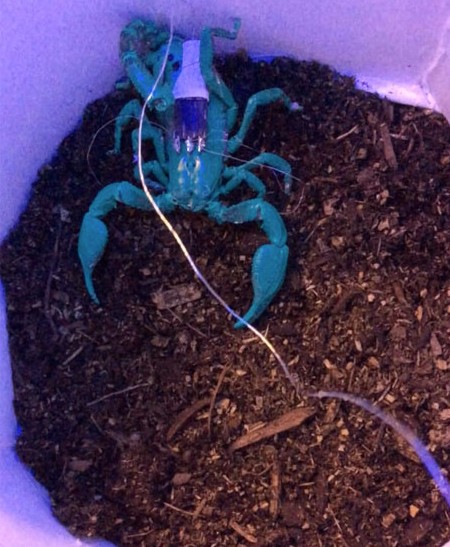
RoboScorpion Featured in Popular Mechanics
“Backyard Brains, a small Michigan-based company dedicated to spreading the word about neuroscience, has been running surgical experiments on these deadly arachnids for the past two months, using electrical current to induce them to strike. Dylan Miller, a summer intern working the project, insists it’s the first time that an electrical current has ever been used to remotely induce a scorpion to strike with its pedipalps (claws) and tail.” Read the full article here.
Your Mentors
This summer you will be trained by Ph.D. Neuroscientists, inventors, makers, seasoned engineers, and public speakers. With the help of our team, each intern will complete a compelling demonstration that the public will be interested and delighted to see. For example, see our recent TED talk on some of our recent work. Yours could be next!
Here’s some testimony from a former Fellow:
“The Backyard Brains summer internship is truly a once in a life time experience. Throughout the summer, we got to work as independent researchers on projects that one wouldn’t typically get to experience in a university setting, which allowed us to explore different realms of our scientific interests and grow immensely as scientists and individuals. I feel so fortunate to have been given the experience to pursue such a unique project, under the guidance of arguably the best boss in the entire world, Greg Gage. He provided guidance whenever we needed it while also allowing us the flexibility to execute a project from start to finish on our own terms. By the end of the summer, we were all able to showcase our work on an amazing platform, and conclude our projects feeling so confident in our abilities and excited to pursue whatever lie ahead for all of us as we returned to school/Work/etc.
I left the internship feeling more part of a family than a company and that is something I will have for the rest of my life. If I could do it over again, I would in a heartbeat!” -H. Smith, 2017 Fellow
Make Discoveries!
This year’s projects will be our most interesting and exciting ones yet!
The Secret life of Jellyfish – Jellyfish have neurons, but no brains. They can show coordinated behaviors like turning and spinning… but how is this possible with no one in control? You will help find out. Using machine learning and a mobile phone camera, we will see if we can crack the code using ocean clytia! This project is in partnership with Dr. Brady Weissbourd of UCLA. Skills required: CS, Neuroscience, Engineering.
Wasp Face Painting – Wasps are known to form a hierarchy. A dominant rank earned through fighting… they only need to fight once to determine the pecking order. But how do the wasps remember their lot in life? This project will look to see if they can recognize each other by looking at their faces. Skills required: Neuroscience.
The Free Will Detector – The task is simple: move your arm. We won’t tell you when to do that… it is up to you. It’s your own free will to do so. Right? Maybe not! If we record your brain signal (EEG), it has been shown that your brain gives some indication its about to move your arm… even before you are aware! Your brain made you do it! In this project, you will use machine learning to predict a movement before the subject is even aware! Skills required: Engineering, CS.
The Electric Fish Piano – Weakly electric fish sing electrical notes to navigate the rivers of South America. It works incredibly well. But if someone else is singing at the same frequency, the interference causes a blindspot. So the fish have evolved to move the note up our down the harmonic scale. What if we had multiple fish? Could we develop a system that “parks” the fish at a given note? Could we actually play a song with many fish? Skills required: CS, EE, Neuroscience.
A Movement Mind-Reader? At BYB we have developed a neuro-prosthetic… a robot claw controlled via the electrical recording of your muscles. People often ask… do I actually have to move my muscle to make the robot move? The answer was yes… but is that true? In this project, you will be searching for “mu rhythms,” or small signatures in the EEG that can encode imagined movements. Can we detect an imagined movement to make a robot claw move? Skills required: CS, Neuroscience, Engineering.
As the Bee Flies – Honeybees tell their colleagues where to find that great patch of pollen they just visited via a wiggle dance. This communication has been shown to encode direction and distance. But how do they actually know how far they went without GPS? The answer is in the eyes… but in an unexpected way. In this project you will set up an experimental hive and experiment by changing the flight path just outside the hive. Skills required: Neuroscience.
What a Plant Knows – The notion that plants can learn in ways that are very animal-like seems too strange to believe… yet scientists have shown that plants can learn many things. Habituation, learning that something you previously thought was scary wasn’t so bad, have been shown in Mimosas… and associative learning have been shown in Pea Pods. We are skeptical, as good scientists are. In this project, you will plant the seeds and grow our understanding… literally. Skills required: Neuroscience, Biology.
Biofeedback for Meditation – Stress is a bummer. It’s a risk factor for neurodegenerative diseases, schizophrenia, and depression. One popular way to reduce stress is to meditate. Studies have shown that meditation has emotional as well as physiological health benefits. Many people, however, struggle in its practice because they don’t have a readout whether they are meditating ‘correctly.’ Studies suggest that our brain activity alters during meditation, increasing frequency and amplitude of the alpha-band. With the Heart and Brain SpikerBox, you can try to reproduce these findings and investigate whether a biofeedback stimulus (Spike Recorder built-in amplitude-to-tone converter) accelerates the meditation learning process. Skills required: CS, Neuroscience, Engineering.
Fastest Claw in the West – The mantis shrimp has the world’s fastest punch… Some species are “smashers” and are capable of smashing open heavy armored clams and crabs, yet other species are “spearers” and have evolved to spear down passing fish with lightning speed. How can the Mantis Shrimp move so quickly? And which type is truly the fastest? You will study the electromyograms of these tiny but mighty animals to gain insights to these questions and more. Skills required: CS, Neuroscience, Engineering.
The Octopus Puzzler – The Octopus is King of the Invertebrate brains. They possess amazingly clever behaviours that allow them to hunt down and kill vertebrates. But just how clever are they? In this experiment, you will be developing “Thorndike Puzzles” for octopodes. You will measure how long it takes the octopus to solve each one, and how much quicker they get in subsequent trials. How does the Octopus stack up to cats and dogs? You will find out! Skills required: Neuroscience.
Become a BYB Research Fellow in 2018, and help start the neuro-revolution!
Apply to the Summer Fellowship Today!
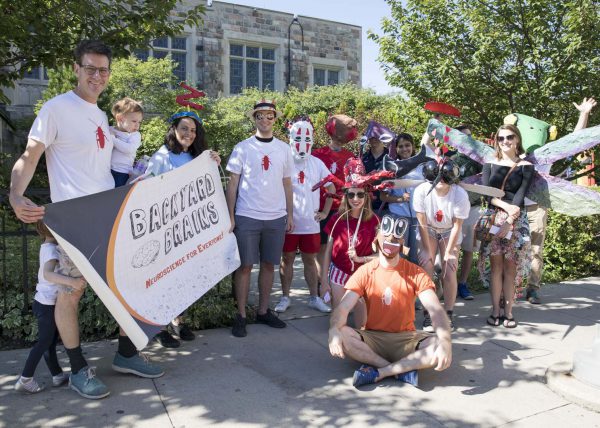
FAQ’s
Where does the fellowship take place?
You will be located at the Backyard Brains headquarters in downtown Ann Arbor (map). You will also be working out of our MakerSpace lab called “All Hands Active.”
Can international students participate?
Yes, we consider all students from all continents.
How much are the interns paid?
The weekly payment is $404/wk.
How much is housing and can you help us find it?
While we do not pay for your housing, we are happy to inform you that summer housing is notoriously easy to find in Ann Arbor, as students leave for the summer and make available sublets. The price varies, but you can find sublet housing on craigslist for under $400. We recommend that you stay close to downtown/central campus.
I am not out of class until June. Can I start a bit later?
We feel that our interns need a full 10w to make significant progress on their projects. If you have a compelling reason on how this will not affect your project, we are willing to evaluate it on a case by case basis.
I am not an undergrad, can I still apply?
While our program is designed for undergraduates… If you are a college graduate, or a super smart High Schooler, we will take your application under consideration.
Is there time off for vacations?
While you will have ample free time in Ann Arbor, we ask that you make the commitment to stay on project for the entire length of the internship.
Are projects assigned to interns or do the interns get some autonomy in deciding the course of their research?
The summer projects are described above and in the fellowship application. Each student will submit the project that they are interested during this process, or can suggest their own ideas. We keep the applicant’s preferences in mind, and we pair a student with a project early on so that the intern will have some time to do some background reading and familiarize themselves with the organism/methods. While we have some idea of the direction or end result of a project, we encourage independent thought throughout the process–some of our most successful projects have come from slight deviations from the original goals. We will send out some suggested papers a few weeks before the program starts.
What about this letter of reference?
